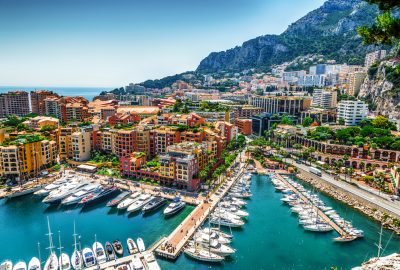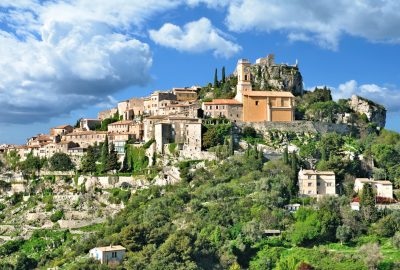Monaco, officially the Principality of Monaco (in French: Principauté de Monaco), is a city-state: a usually autonomous mini country. Worldwide it is one of the three that are completely sovereign alongside Singapore and Vatican City. Monaco is in a close relationship with France, and even though Monaco is not a member of the EU, they do have a say in many European matters and have adopted Euro as the official currency. There is traditionally a lot of confusion about the difference between Monaco and Monte Carlo. While Monaco the name of the country, Monte Carlo refers to one of its neighborhoods. Monte Carlo is the most famous one because it is situated in the heart of Monaco. It’s the district where most people live and most tourists to see iconic places such as the Casino and Café de Paris. In total Monaco is divided into four districts/neighborhood: Fontvieille, La Condamine, Monaco-Ville, and last but not least: Monte Carlo.
Even amongst the resort of the French Riviera, this city is in a league of its own. Every other guy drives a Ferrari to buy groceries; everyone else has servants that do that for him. What makes it such a paradise for the rich and famous? No income tax! That explains why it’s the wealthiest country in the world (per capita). For regular people Monaco is like a zoo, or a theme park, where you can watch rich people in their natural habitat, but how does it look from the other perspective? Waking up in terror after dreaming about dirty plebeian fingerprints on your Ferrari? Being filthy rich must be hard. How do the Monégasque spend their time, apart from sunbathing on their yachts and picking up supermodels? They role-play James Bond and risk their enormous fortunes in one of the most iconic casinos in the world: Le Grand Casino de Monte Carlo.

Port Hercules: a natural bay and the only deep-water port of the Principality of Monaco, which is in use since ancient times
The Grimaldi House has ruled Monaco since the 13th century, had its up and downs and figured that the remedy to all their problems is of a financial nature. Charles the Third built a stunning casino and the cash started flowing in, after all “the house always wins”. It was so successful that Monaco’s entire rise to glory is attributed to that one building. The Grimaldis couldn’t manage the casino all that well. So they left the boring stuff to a family of French casino nerds and focused on counting the dough. That family was called the Blancs and they contributed to so much more than just the gambling. They actually turned Monaco into a tourism and cultural powerhouse that it is today. Charles III established the Société des bains de mer de Monaco, SBM in short, which to this day governs all the most important money cows in town, including the casino, the Hermitage Hotel and many others. It sounds like something a Bond villain would launder his dirty money in.
The name Monte Carlo, Monaco’s most famous and popular city quarter, translates to Charles’ Hill or Charles’ Mountain. The area used to be called Les Spelegures, meaning “The Den of Thieves”, which would be a too literal name for a casino. There are two other iconic buildings located beside the famous gambling establishment: Hotel de Paris and Café de Paris. The hotel was built in 1863 and it’s one of those buildings that you just recognize, remember you’ve seen them somewhere. This place was in so many photo-shoots and movies that it has become a worldwide famous icon. It starred in the Iron Man (the F1 race scene was also shot in Monaco) and its rooms were baptized by numerous Bonds and Bond Girls, royalty and celebrities. Hotel de Paris also features world-renowned, Michelin-starred restaurants and one of the best bars in Europe. Café de Paris is the final part to this fabulous trio of Monte Carlo. Built in 1868 and rebuilt many times over the years, it must have seen thousands of victims or victors emerging from the Casino to spend their newly acquired fortune on a luxury meal. Some, on the other hand, must have spent their last remaining pennies on drinks, to drown their sorrows. The Hermitage is another landmark hotel for the filthy rich, designed by Gustave Eiffel. That is the same guy that designed that tower in Paris you might have heard of.

The picturesque Eze, located between Nice and Monaco, is a medieval village on a high rock offering stunning views of the French Riviera from Italy to St. Tropez
I know this all sounds like a resort for old millionaires and billionaires and it totally is. But there’s much more to it. There are a few things that normal folks can do in Monaco. Monte-Carlo Pavilions are five futuristic buildings where the most extravagant fashion brands sell their goods, a great spot to window-shop. Port Hercules (Port Hercule) is a famous yacht marine, another place where you can drool over things you probably will never have. Why the name and what has it got to do with Monaco? The mythological hero passed through Monaco, before it was even known as Monaco. So the locals had to build him a Temple of Hercules Mònoikos. Mònoikos, Monaco: close enough. Either way, the port has been functional for centuries, but now its main role is housing of the most impressive floating villas in the world. Wake up early, grab a cup of coffee and spend your morning watching people kill themselves trying to find work on one of those monumental boats. Spending a day at one of the beaches isn’t all that bad either.



No one commented yet. Be the first.